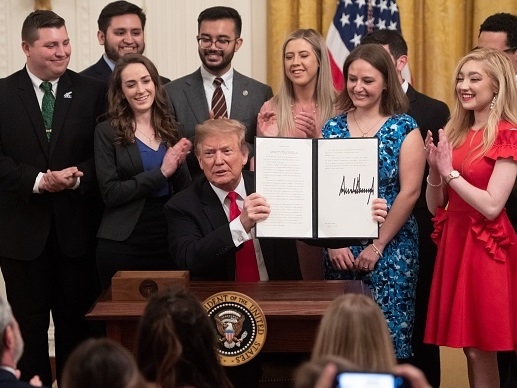You have /5 articles left.
Sign up for a free account or log in.

President Trump signs executive order.
Getty Images
Valentines with religious messages. Tiny crosses on the university lawn. An activities table on the campus plaza. President Donald J. Trump chose the softest of human props as the backdrop for his executive order on campus free speech. As he brought each alleged victim of collegiate “political indoctrination” to the podium at the White House, the audience erupted in cheers for these hapless students martyred by “speech codes, safe spaces and trigger warnings.”
The three speakers at Trump’s ceremony were all young white women. As the camera panned the room, the overwhelming whiteness of the audience was clear. Certainly, some people of color were present for the occasion, but they were not featured prominently. Where were all of the African American students who suffer racial slurs and horrific threats on campuses every day? Where were the Latinos, the Dreamers, the LGBTQ students who often endure egregious hostility and intimidation during their college years?
A suspicious odor wafts through Trump’s executive order that only one kind of student is worthy of protection -- namely, the student whose political views he favors. He said at the ceremony that this order is the beginning of a more aggressive stance to protect student rights. Has the president spoken as boldly about protecting the rights of students of color on campus? Does his freedom of speech order cover the myriad displays of nooses, bananas, swastikas, blackfaces, N-word scrawls and other racially offensive expressions that some students suffer regularly?
This is the same president who insisted that there were “some very fine people on both sides” in Charlottesville, Va., where Heather Heyer died while exercising her own right to speak out against racial hatred -- a vibrant young woman mowed down by a white supremacist who was there as part of a protected-speech right-wing rally. Trump lifts up the “brave” anti-abortion cross planter who was simply told to include an explanatory sign on her display, but he never extolled Heather Heyer’s bravery for giving her life as part of her exercise of freedom of speech. Trump mocks “trigger warnings” while soothing the valentine maker who was only allowed to distribute her “Jesus Loves You” cards in a specific place on campus, even as he says not a word of care or concern for those who suffer not only taunts but also real assaults at the hands of white supremacists, neo-Nazis and the assorted other contemptible hate groups that operate with gleeful insouciance in the Trump era.
Freedom of speech is essential to our work at colleges and universities -- but it’s not the only right or value in play on a campus. Higher education institutions have a distinct obligation to ensure the safety and security of all students; one person’s free expression can, quite often, come across to others as offensive, intimidating, even threatening.
It’s certainly true that conservative students sometimes suffer harsh and inappropriate reactions. One of Trump’s guests was a student from the University of Nebraska who set up an information table for a conservative group, Turning Point USA, and she was understandably offended by a graduate student lecturer screaming at her while waving a middle finger -- but that ugly expression, too, is free speech. It’s also true that students of many different political, religious and cultural identities suffer insults, bullying and worse -- especially when they become visible activists for their cause on a campus. Booing, heckling and ringing cowbells to express disagreement with a speaker is certainly offensive, but it is also part of free speech. To manage the campus for peace and productive exchange of ideas, administrators must exercise continuous care to understand how listeners hear what speakers are saying, how offensive and insulting speech might provoke a reaction that can easily become violent.
We cannot protect students from feeling hurt or angry because of someone’s expression, but we have a serious obligation to protect everyone from harm. One of the students at Trump’s ceremony said, “Speech is not free when university officials put conditions on student speech.” In fact, we can and do have reasonable regulations for the time, manner and place of speech so that we can manage the daily life of the institution. Respect for freedom of speech requires that we exercise prudence in the management of those regulations, allowing as much expression as is reasonably possible, neither favoring nor inhibiting any speech because of its content.
The university is, first and foremost, a teacher, and our teaching extends to developing in students the ability to listen, learn and grow beyond narrow personal biases, to develop a worldview based on knowledge and critical reasoning. Rather than girding for political combat over the distribution of religious valentines, a more productive educational response would have fostered dialogue among the valentine maker, those who objected to her messages and the administrators trying to manage the myriad points of view. Learning can only occur in constant dialogue, not by presidential edict or political interference. Dismissing a college or university’s expectations for civility, respect and inclusiveness as mere “political correctness” insults the teaching mission and undermines opportunities for learning among all students -- liberal, moderate, conservative and politically agnostic alike.
A Not-So-Hidden Agenda
Trump’s executive order runs roughshod over any such considerations. Trump’s own words make it clear that the executive order is all about protecting one kind of speaker -- those toward the right side of the political spectrum. He said he was “delivering a clear message to the professors and power structures trying to suppress dissent and keep young Americans … from challenging rigid far-left ideology.”
By the voices he chose to lift up, the president’s ideological agenda is very clear. Trump gave a big shout-out to Charlie Kirk of Turning Point USA, sitting in the front row, and Kirk put out this statement after the ceremony: “Today’s executive order is the culmination of Turning Point USA’s tireless work to break the left’s stranglehold on campus, a grip that has suffocated the free exchange of ideas and helped indoctrinate an entire generation to hate America.”
Restraining the freedom of universities is a not-so-hidden agenda in this executive order. While excoriating universities for what he called “ideological intolerance,” Trump did not hesitate to use the power of his office to bully universities, citing federal research funds as the carrot at the end of the stick. As much as $35 billion is at stake, he proclaimed to the wild cheers of aggrieved audience members, and “if a college or university does not allow you to speak, we will not give them money.” What a great lesson in political intimidation!
We must use our freedom of speech to expose the lie at the heart of the president’s executive order: the order threatens the very freedom it claims to protect. No president, no executive bureaucracy should have the authority to say what is or is not speech that is worthy of protection on a college campus. Our Constitution and system of laws already provide clear protection, and the judicial process is the appropriate place to seek protection in any case where the First Amendment guarantee of freedom of speech is compromised.
Let’s not forget that this is an administration that denies climate science, that has purged executive agency websites and programs of language like “refugees,” “transgender” and “nation of immigrants.” Controlling language and speech is a big part of the authoritarian formula. It’s a short step from saying that the valentine maker should be allowed to distribute her wares anywhere she pleases on campus to mandating teaching “both sides” on climate science, or evolution, or slavery, or immunization policy, to prescribing curricula and onward to compelling universities to invite certain speakers or, ultimately, to disinvite others. That’s how the authoritarian state works -- methodically, insidiously, one loss at a time down the slippery slope until all is lost.
Leaders in higher education need to be more audacious in calling out the real agenda behind the president’s executive order. Rather than simply saying, “Well, we’re already doing that,” or “It wasn’t as bad as we anticipated,” we need to use our freedom of speech to confront the not-so-subtle undermining of the autonomy and power of higher education as a counterweight to a government marching headlong into authoritarianism.








